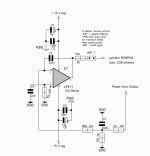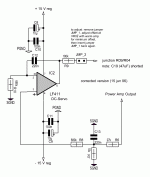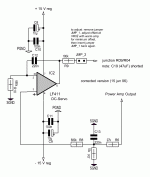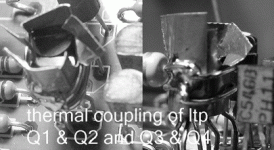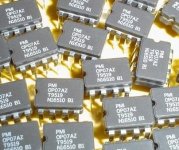SKA & DC servo
Hi AndrewT,
unfortunately I cannot understand your first sentence...
To the DC-servo:
When shorting C9 you get a higher gain at DC ( 29dB ) and so a slight DC offset might show up at the output, even after careful adjustment of VR2. This is assuming no DC component at the input! Otherwise, this input DC component will be amplified times 28 at the output. Beware!
The SKA has a very symmetric circuit topology, giving no noticeable thump at switch-on. At least my 300D does so.
To remove any hint of DC at the output terminals, with C9 shorted, a DC servo will do a good job. Having a low corner frequency, it will not interact with the music programme signal. If the DC servo is too fast, it will try to "neutralize" the low frequency part of the signal spectrum. Using bi-amping configurations, this might be wanted, to remove any lower freq. out-of-band signal that might damage the midrange or tweeter speakers. In such a case, the integrating and filter capacitors have to be reduced accordingly (C3 and C7 in my circuit), see attached file.
I plan to use the same kind of servo at the output stage of my pre-amp, bringing the DC offset down to zero (almost, just a few tens of micro volts from the offset of the opamp).
Hope this helps you a bit.
Regards,
stoeffle.
AndrewT said:Hi Stoeffle,
am I allowed to say "what if" and "speaker protection" in the same sentence?
Adding DC servo and eliminating both DC blocking caps is a nice philosophy.
How does it turn out in practice?
Hi AndrewT,
unfortunately I cannot understand your first sentence...
To the DC-servo:
When shorting C9 you get a higher gain at DC ( 29dB ) and so a slight DC offset might show up at the output, even after careful adjustment of VR2. This is assuming no DC component at the input! Otherwise, this input DC component will be amplified times 28 at the output. Beware!
The SKA has a very symmetric circuit topology, giving no noticeable thump at switch-on. At least my 300D does so.
To remove any hint of DC at the output terminals, with C9 shorted, a DC servo will do a good job. Having a low corner frequency, it will not interact with the music programme signal. If the DC servo is too fast, it will try to "neutralize" the low frequency part of the signal spectrum. Using bi-amping configurations, this might be wanted, to remove any lower freq. out-of-band signal that might damage the midrange or tweeter speakers. In such a case, the integrating and filter capacitors have to be reduced accordingly (C3 and C7 in my circuit), see attached file.
I plan to use the same kind of servo at the output stage of my pre-amp, bringing the DC offset down to zero (almost, just a few tens of micro volts from the offset of the opamp).
Hope this helps you a bit.
Regards,
stoeffle.
Attachments
Hi Andrew T,
Agree that DC-detection circuit will be good insurance. In fact, i have at shelf couple of Welleman K4700 DC protection kits but have been too lazy to install them. And to SKA:s i will need 4 pcs mono protection, Wellemans are stereo. Also, i do not like to add extra relays (and some wiring) even to power supply line.
Noise from crossover is NOT issue at all and this 6-ch attenuator is only "excessive self-defence" and because is fun to play with some things. .
Also looking for better desing than Orion is not option to me at all. I am absolutely happy to these speakers.
Agree that DC-detection circuit will be good insurance. In fact, i have at shelf couple of Welleman K4700 DC protection kits but have been too lazy to install them. And to SKA:s i will need 4 pcs mono protection, Wellemans are stereo. Also, i do not like to add extra relays (and some wiring) even to power supply line.
Noise from crossover is NOT issue at all and this 6-ch attenuator is only "excessive self-defence" and because is fun to play with some things. .
Also looking for better desing than Orion is not option to me at all. I am absolutely happy to these speakers.
Re: SKA & DC servo ERROR CORRECTION OF SCHEMATIC !
Due to an error on my side (the problem is between the headphones, as pilots say...), I loaded the wrong schematic.
please disregard the one posted yesterday. This one is the corrected one.
Sorry... on my head!
on my head!
stoeffle
Due to an error on my side (the problem is between the headphones, as pilots say...), I loaded the wrong schematic.
please disregard the one posted yesterday. This one is the corrected one.
Sorry...
 on my head!
on my head!stoeffle
Attachments
AndrewT said:Hi Stoeffle,
I have seen DC servos with a low pass filter on the input and the low pass feedback around the opamp. Your's is the other type with just the feedback low pass.
Why do it this way?
What are the advantages (besides saving a cap) and disadvantages?
Hi AndrewT,
First of all, op-amps used as DC-servos have to have a high open loop gain (for high precision) as well as minimum offsets (current und voltage). Otherwise we would add DC offset errors...
Usually, for cost reasons, op-amps with these features and low cost have very limited gain-bandwidth producs (= slew rate). Thus, to avoid overloading the op-amp (SR overload), we add a capacitor to form a LP-filter at the input and cut-off the high frequency (= high SR) parts of the signal.
The low-pass at the feedback you mention is the real working part, the integrator. As long as there is a difference at the input terminals, the integrator will ramp up (or down) its output, thus correcting the offset generated by the long tailed pairs at its input stage.
The DC-servo output should inject a correcting current into the node R9 / R14 (and not R04
 as printed in my schematic). Its too hot here...
as printed in my schematic). Its too hot here...The integrator in my design has a cut-off freq of abou 1 Hz.
You may increase this frequency in SKAs driving midrange speakers or tweeters accordingly. In doing so, your compound (SKA + DC-servo) will react much faster to dc offsets.
stoeffle.
Attachments
stoeffle said:as well as minimum offsets (current und voltage)
Stoeffle,
you don't regard the LF411 as outdated for about 15 years in that respect ?
SKA LTP improving thermal stability
Discussing the issue of thermal coupling of the LTPs (Q1&Q2 and Q3&Q4) with Greg Ball, I showed him a pic of my modification.
He suggested to bring it up in this forum.
The difference amplifiers will give a better DC-offset performance when there is a tight thermal coupling between both transistors involved.
Ideally, a double transistor pair would be the ideal part, but these are rather costly. To get the substrate temperatures closer, it is good practice to join the casings with a metal clamp.
I did this with a small stripe of 0.1mm copper foil, to which I added small transversal cuts to be able to twist the excceding length, to get some heat dissipating fins. This in part helps to reduce the problem induced by thermal memory effect (see: http://peufeu.free.fr/audio/memory/ for a good explanation). Inside the coupled parts, I smeared some small amount of heat compound for a good heat transfer. Fixing it with a short piece of copper wire wrapped around or a small cable tie wrapper finishes the work.
A better result can be achieved placing the transistor cases face to face, with their flat sides facing one each other, but this requires either a dangerous twist of the leads or a change in the layout.
stoeffle.
Discussing the issue of thermal coupling of the LTPs (Q1&Q2 and Q3&Q4) with Greg Ball, I showed him a pic of my modification.
He suggested to bring it up in this forum.
The difference amplifiers will give a better DC-offset performance when there is a tight thermal coupling between both transistors involved.
Ideally, a double transistor pair would be the ideal part, but these are rather costly. To get the substrate temperatures closer, it is good practice to join the casings with a metal clamp.
I did this with a small stripe of 0.1mm copper foil, to which I added small transversal cuts to be able to twist the excceding length, to get some heat dissipating fins. This in part helps to reduce the problem induced by thermal memory effect (see: http://peufeu.free.fr/audio/memory/ for a good explanation). Inside the coupled parts, I smeared some small amount of heat compound for a good heat transfer. Fixing it with a short piece of copper wire wrapped around or a small cable tie wrapper finishes the work.
A better result can be achieved placing the transistor cases face to face, with their flat sides facing one each other, but this requires either a dangerous twist of the leads or a change in the layout.
stoeffle.
Attachments
LF 411
hi Jacco,
well, it maybe "outdated", but it is a proven device and rather cheap!
For sure, you may look for a similar "modern" device a pay a lot more... it is up to you. We are not talking about ppm of THD or similars, but about precision DC opamps. Choose as you like .
.
stoeffle.
jacco vermeulen said:
Stoeffle,
you don't regard the LF411 as outdated for about 15 years in that respect ?
hi Jacco,
well, it maybe "outdated", but it is a proven device and rather cheap!
For sure, you may look for a similar "modern" device a pay a lot more... it is up to you. We are not talking about ppm of THD or similars, but about precision DC opamps. Choose as you like
stoeffle.
peufeu link on thermal memory
sometimes this server does not respond.
for those interested, I will be glad to send you the file by email.
just send me a note to mail@cktm.de.
stoeffle.
sometimes this server does not respond.
for those interested, I will be glad to send you the file by email.
just send me a note to mail@cktm.de.
stoeffle.
stoeffle said:rather cheap!
People do not seem to mind spending fortunes on exotic capacitors but when it comes to chips even a few quarters is too much.
Attachments
jacco vermeulen said:
People do not seem to mind spending fortunes on exotic capacitors but when it comes to chips even a few quarters is too much.
well, I try to spend my money where I get the best results in value for money.
Maybe I am at the wrong forum anyhow...
BTW: the OP07 in your pic is a good alternative. But, as far as I know, also an "oldie", originally introduced by Precision Monolithics Inc (now not existing anymore, bought up by Analog Devices) ... but still going strong.
You may also opt for LT1001... also on the market for quite a long time, as many others.
BUT: regarding capacitors, matters are quite different...
I just would like to recommend a look on the article series about "Capacitor Sound" in the follow up magazine of Wireless Electronics a couple of years ago... It was eye-opening, if not to say ears-opening!
I scanned these articles, as they are very interesting, but the CDROM is hard to find at the moment. Must search my collection....
stoeffle.
stoeffle said:Maybe I am at the wrong forum anyhow
Me too!

I wasn't implying to use the opamp i posted. The only one i know of who has this NOS military version opamp is a French retailer that lists it between 15 and 20 Euro.
Those who intend build the GB150 themselves will also find it hard to find a supplier of the BC devices.
An OP07CP costs only $0.50
Fischer produces a TO5 heatsink that can thermally couple a BC duo, SKK510
jacco vermeulen said:
Those who intend build the GB150 themselves will also find it hard to find a supplier of the BC devices.
An OP07CP costs only $0.50
Fischer produces a TO5 heatsink that can thermally couple a BC duo, SKK510
To the Fischer SKK510: yep, this will work, BUT only if you manage to align your two TO-92 BCs flat face-to-face, which is not the case in the original layout delivered by Greg...
BCs: in the 300D
The easy ones:
BC546B (Q5, 6, 9, 13,14, D10) @ RS, # 296-071, for 14 EURcent
BC556B (Q7, 8, 10, 11, 12, D9) @ RS # 348-9434, for 5 EURcent
The others are harder to get:
BC546C at www.kessler-electronic.de, 0,059 EUR (25+)
BC556C at www.diotec.com (?),
The problem is the extreme high hFE (420..800) of these "CE devices. Perhaps someone here at diyAudio knows a substitute?
There must be sources in the US or Australia, as Greg seems to get them easy..
stoeffle.
anatech said:Hi stoeffle,
Fixed your link, it works now.
-Chris
Hi Chris / anatech,
great job! many tnx!
stoeffle.
stoeffle said:There must be sources in the US
BobEllis
Hi Pasi P.,
Thanks for contributing your listening impressions.
As I am currently in the process of building a pair of Orions, your experience with Orions and different amps is of great interest to me, as I haven't decided on which amps to use. I'd really appreciate it if you could take the time to answer a few questions:
1. Have you tried swapping your UcDs and SKAs, so that SKAs drive the bass? If so, do you consider your UcD amp superior for driving the Orion basses? Do you think a hybrid setup such as yours is superior to an all-SKA setup?
2. How do you compensate for the difference in gain between UcD and SKA?
3. Which UcD modules are you using?
Thanks in advance!
Thanks for contributing your listening impressions.
As I am currently in the process of building a pair of Orions, your experience with Orions and different amps is of great interest to me, as I haven't decided on which amps to use. I'd really appreciate it if you could take the time to answer a few questions:
1. Have you tried swapping your UcDs and SKAs, so that SKAs drive the bass? If so, do you consider your UcD amp superior for driving the Orion basses? Do you think a hybrid setup such as yours is superior to an all-SKA setup?
2. How do you compensate for the difference in gain between UcD and SKA?
3. Which UcD modules are you using?
Thanks in advance!
I have had my GB150s running for a couple of weeks now, here is my subjective appraisal:
A very nice sounding amp with good clarity, detail, timing and pitch
definition which makes music in a tuneful and coherent manor. It loses the frequency extremes just a little compared to my favourite power amp - Leach low TIM.
I would say it is better than most of the other amps I have built though - AKSA, NCC200, Aleph, JLH 80W mosfet, Borbelly DC100 to name a few.
FWIW I prefer both the Leach and the GB150s to my Leak ST20 and my Grant G50 (PP EL34) valve power amps.
In terms of value for money, ease of build and sound quality the GB150 really is an excellent amp.
Caveat - the amps use different power supplies:
The Leach uses a 1KVA transformer (4 secondaries) with 10,000uF BHC caps per rail.
The GB150s use 2 X 225VA transformers with 2X 4700uF Kendeils per rail.
A very nice sounding amp with good clarity, detail, timing and pitch
definition which makes music in a tuneful and coherent manor. It loses the frequency extremes just a little compared to my favourite power amp - Leach low TIM.
I would say it is better than most of the other amps I have built though - AKSA, NCC200, Aleph, JLH 80W mosfet, Borbelly DC100 to name a few.
FWIW I prefer both the Leach and the GB150s to my Leak ST20 and my Grant G50 (PP EL34) valve power amps.
In terms of value for money, ease of build and sound quality the GB150 really is an excellent amp.
Caveat - the amps use different power supplies:
The Leach uses a 1KVA transformer (4 secondaries) with 10,000uF BHC caps per rail.
The GB150s use 2 X 225VA transformers with 2X 4700uF Kendeils per rail.
- Status
- This old topic is closed. If you want to reopen this topic, contact a moderator using the "Report Post" button.
- Home
- Amplifiers
- Solid State
- Simple Killer Amp - Listening impressions
